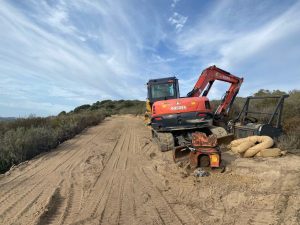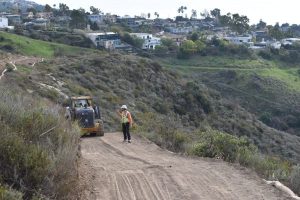On Jan. 4, Janine Robinson set out on her daily morning walk in the area around Alta Laguna Park. However, what the Top of the World resident saw carved into the wilderness below was anything but routine.

Several dirt paths, approximately 20 feet wide and estimated to be one to two miles long, had been bulldozed into the city-owned open space creating a prominent blemish across the landscape west of Alta Laguna Boulevard and north of Park Avenue.
The SCE grading looking north at Top of the World on Jan. 18. Clara Beard/LB Indy
Robinson, who immediately contacted the Top of the World Neighborhood Association about her discovery, wasn’t the only citizen with raised eyebrows and questions.

“Imagine my reaction when my son came running into the house asking why people in bulldozers were ‘wrecking the ground in our front yard,’” A Park Avenue homeowner wrote in an email to the Indy. “How do you answer such an improbable question?”
Contractors take steps to mitigate potential erosion before the weekend rainstorm on Jan 18. Clara Beard/LB Indy
After a week-long flurry of emails and calls back and forth to city and county officials, concerned residents and local environmental groups discovered that not only was Southern California Edison (SCE) responsible for the bulldozed paths, it was doing so without City and Coastal Commission permits.
On Jan. 11, Laguna Beach Interim City Manager Sean Joyce asked SCE to temporarily stop their repairs until the city could learn more about the circumstances.

“If citizens and environmentalists hadn’t alerted the city as quickly, and the city, namely Sean Joyce and Sue Kempf, hadn’t been so amazingly responsive and got them to stop immediately, they would have kept bulldozing, literally that next day, and could have caused more than double the amount the damage they already did,” Robinson said. “It’s not often the city and environmentalists team up so effectively and successfully and cause an all-powerful utility to stand down—and do the right thing.”
SCE engineers inspect one of the five electrical poles scheduled for repairs at Top of the World. Submitted photo
According to SCE Saddleback District Manager Robert Maystrovich, the public utility company was in the process of necessary repair work in the open space when engineers ran into a series of electrical issues, which, coupled with high winds, created an emergency situation.
“These new circuit loading and reliability risks to critical loads, including City Hall, along with the extreme fire risk caused by the initial weather event, led my team reclassifying this section of work as emergency,” Maystrovich explained in correspondence with Joyce, that he in turn, shared with all concerned parties in an email blast.
“As we shifted into the heavy terrain section, it was determined that the original construction plan to utilize helicopters to remotely fly in construction personnel and material was not viable due to the overgrown native vegetation,” Maystrovich wrote. “As we were without a place to physically and safely land them, this was no longer an option.”
Still, SCE lacked the necessary permits from the City and the Coastal Commission, prompting an emergency meeting with representatives from all three entities on Tuesday, Jan. 16.
“SCE agreed to submit an emergency Coastal Development Permit (CDP) imminently,” interim city manager Sean Joyce wrote in his report update on Jan. 18. “City staff met virtually with Coastal Commission staff this morning to confer about a variety of matters associated with the work performed and planned by SCE associated with its cover conductor project.”
Joyce said SCE has agreed to use helicopters for the pole replacements to avoid any further impacts on the habitat. SCE also hopes to complete its repairs before the threatened coastal California gnatcatcher begins its nesting season on Jan. 31.
SCE reports mitigation and restoration efforts are estimated to take five to 10 years. And with the popularity of Alta Laguna Park and the surrounding trails increasing, residents have expressed concern the bulldozed paths could be mistaken for public trails by visiting hikers, creating erosion.
Laguna Canyon Conservancy President Gayle Waite said she’s learned from meetings with the Southland Region Power in Nature Coalition that electric companies have caused this type of wildland destruction in other parts of California.
“When caught, they (electrical companies) are made to do mitigation, but it is usually too little, too late, and does not seem to stop them from repeating the behavior,” Waite wrote in an email to the Indy. “SCE should be forced to pay a big fine, but then residents and taxpayers will foot the bill and electric rates just go up.”
An SCE spokesperson is scheduled to give a presentation about the pole replacement project and its next steps during the upcoming Laguna Beach City Council meeting on Tuesday, Jan. 23 at 5 p.m.
“Laguna Beach city officials and the Coastal Commission should hold SCE senior management accountable since if these repairs were truly emergency ones, how is it possible neither was consulted and made aware of them?” Waite said. “Shouldn’t the city at least been alerted to a potential electrical emergency and have the fire department on notice? The public would like to know.”